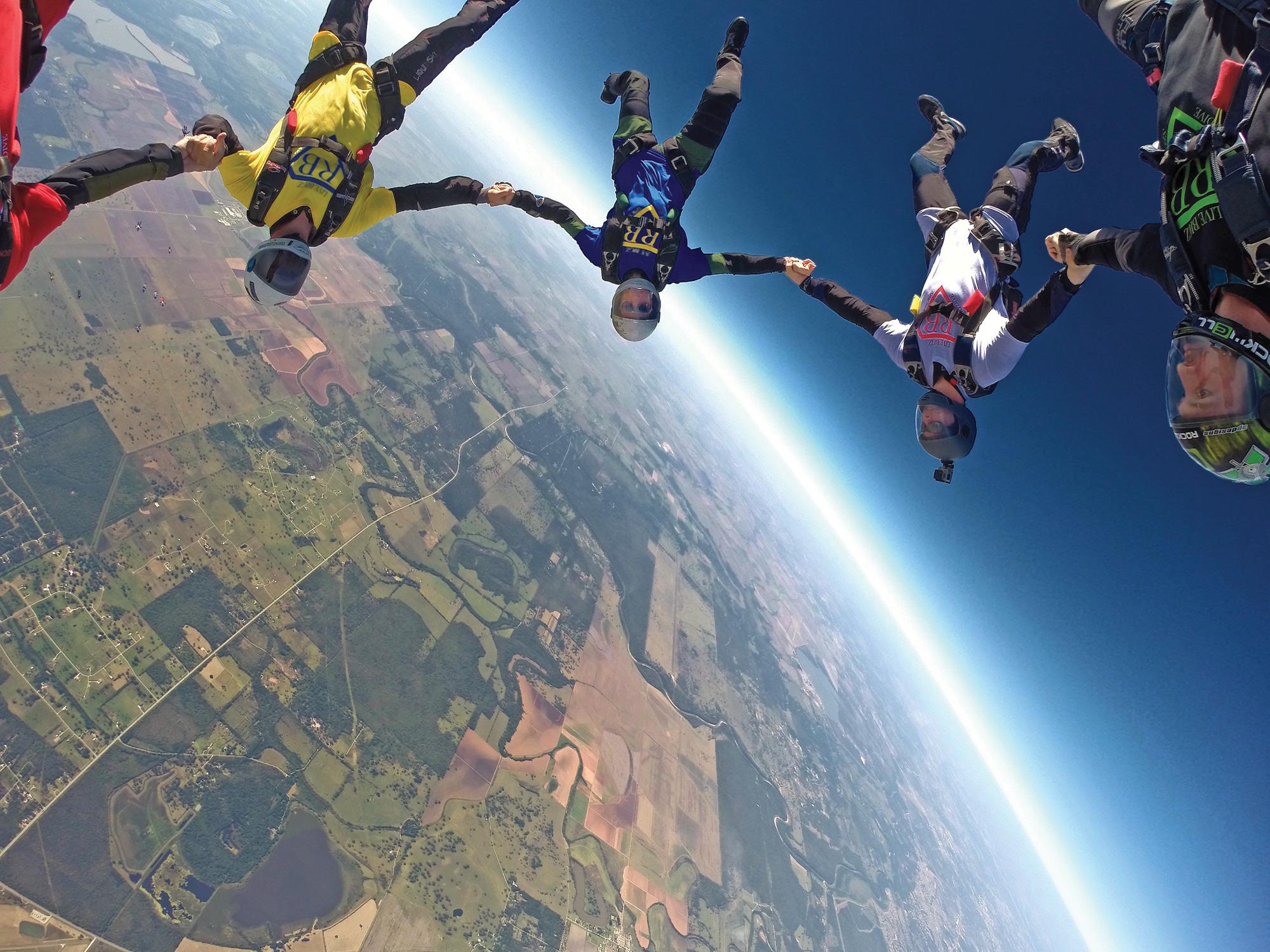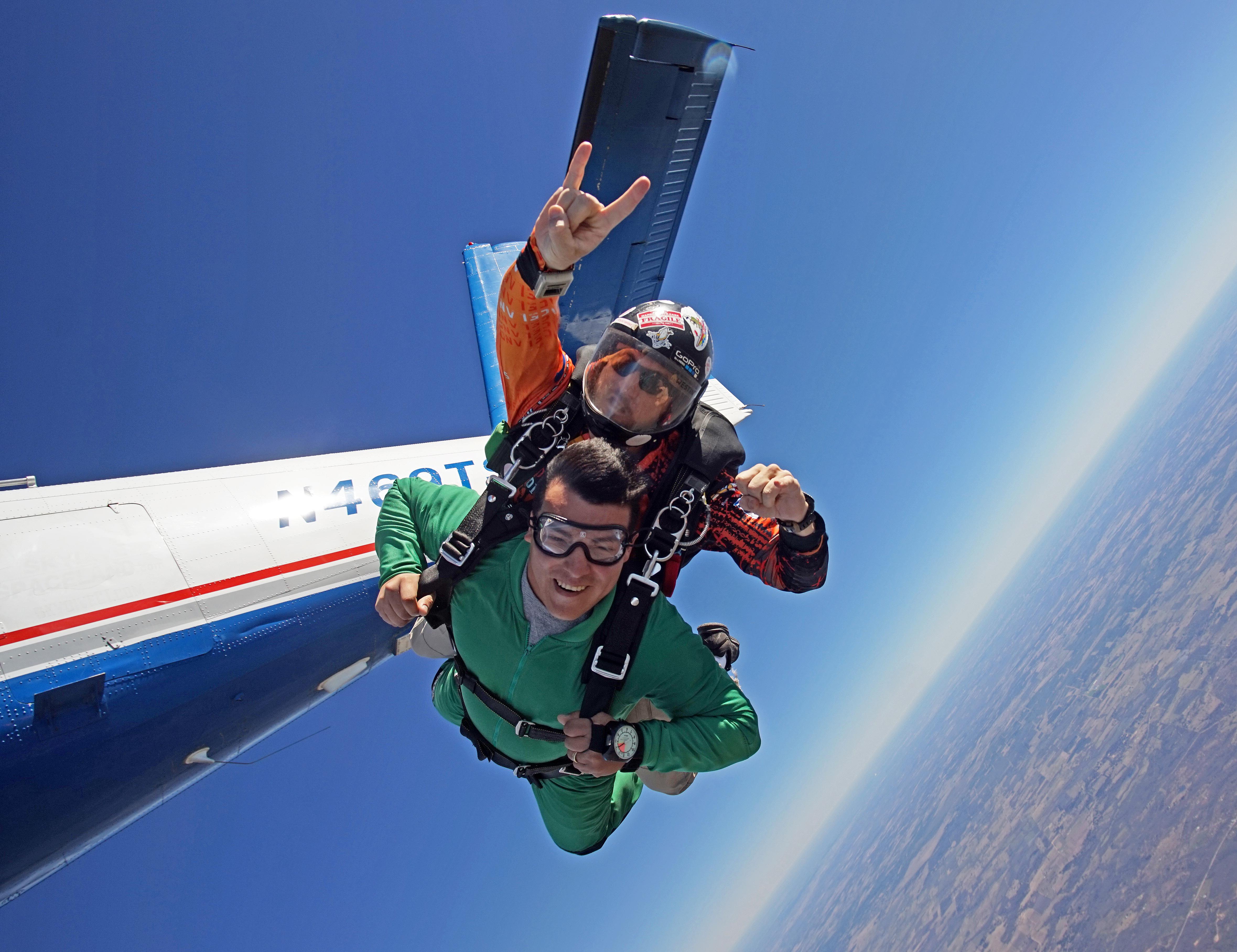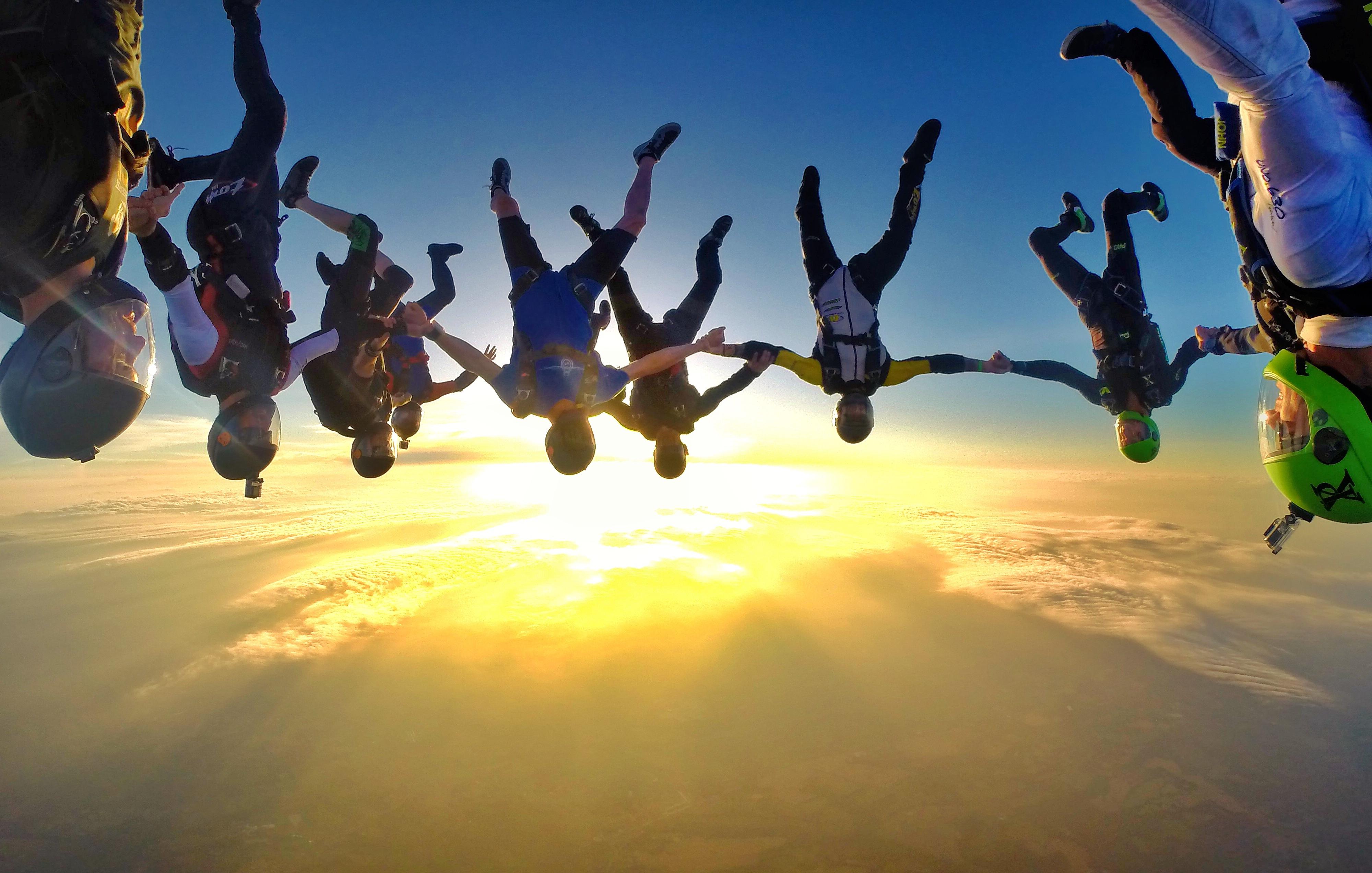
GAskygirl
Members-
Content
94 -
Joined
-
Last visited
-
Days Won
3 -
Feedback
0%
Content Type
Profiles
Forums
Calendar
Dropzones
Gear
Articles
Fatalities
Stolen
Indoor
Help
Downloads
Gallery
Blogs
Store
Videos
Classifieds
Everything posted by GAskygirl
-
There is a lot of good advice here. One of the best points is to minimize the number of new things on any one jump, and realize that new things are new for more than just a couple of jumps--it takes quite a few to make that "new" thing "routine." Regarding specific canopies...there is no one best canopy for a given situation. Everyone flies a canopy a little differently. That's why we have so many canopy choices. For example, one might tend to flare a bit late, so a pretty responsive canopy might work well for them to recover. Someone else with an equal exit weight might tend to flare too soon; that responsive canopy might stall in that situation, so a more forgiving canopy might be better for that person. The best thing one can do to find that perfect canopy, as Jimbo said, is demo, demo, demo...and talk to the manufacturers' reps. The bottom line, though, is how capable a person is with the canopy in various conditions. (realistically, not defensively) My own experience--I haven't tried a Vengeance yet, but have had a great time under my Stilettos (120s and now 107s) for over 1,000 jumps, belly flying, freeflying, and some camera flying. But other people hate them. It depends on what you like. Blue Skies! -=Christy=- D-21464
-
First student canopy: Falcon 260 (exit weight about 150#). A few jumps on a Raider 220. A few jumps on a PD 190. A few jumps on a Pro 170. Bought a Falcon 150 @about 30 jumps, jumped it for about 100 jumps. I was lucky. Don't downsize that fast. Even though I still only ended up with a 1:1 loading under that 150, it was way faster than what I initially trained under, and that nearly bit me in the butt pretty good once. I'd recommend buying a good used canopy (i.e., one your instructor thinks is suitable for you and that is in good shape). There are plenty of them out there. Blue Skies! -=Christy=- D-21464
-
Been there, done that, had the surgery. Life is good now. :-) Mine tweaked painfully on creepers one day, then dislocated on the next two jumps in a row (two weeks apart). First time, it went back in on deployment. Of course it was my right shoulder, Murphy is well and strong! The next one required an ER visit to put it back in. I had surgery several months later, skydiving with a brace in the meantime and for seven months afterward (two months off jumping, seven with the brace), and so far so good. In researching the surgery, success rates, etc., the info I found said that in young, athletic people who continue to do the activity they were doing when they dislocated the shoulder, there was around a 90% recurrence rate. Careful with those shoulders...they can be very hard to fix completely due to the high mobility of that joint. I'd suggest that you get it checked out so you'll know if it needs to be fixed and is fixable before you hurt it worse. Blue Skies! -=Christy=- D-21464
-
Me too. Being on a 4way team, I am often in the first group out on a dropzone with a large percentage of freeflyers, so there is always another group behind me. And it's not at all rare for the group behind us to end up too close, regardless of what they're doing. I've even tracked about 45+ degrees off line of flight to have the second group open up down the line of flight from me. My track isn't terrible, but breaking off no higher than 4000 feet, it's not good enough to cover safe horizontal separation distance and then enough extra to PASS the next group out. All of us are probably revved up on adrenaline when the door opens and it's time to exit (if we aren't, then why are we jumping? ;-). This is why more experienced jumpers often exchange a knowing look when a newbie talks about giving you ten seconds out the door, when it was really more like five and you know it. When you're keyed up, patience isn't a strong suit. That's natural. This is why, in my opinion, exit separation is often too short. Add this to the almost guaranteed fact that on a large aircraft, if there are people exiting behind you someone will tell you to hurry it up. Add this to the concern that we all have about landing off, and you can end up with a lot of rushed climbouts and exits...and a much more dangerous lack of proper horizontal separation. Horizontal separation is paramount. A freefall collision will very likely kill you. So avoid it at all costs--give the group ahead of you enough separation. If you're not sure how much time to give, ask the pilot, a jumpmaster, or some other experienced jumper what they would do with the day's winds. And if someone behind you doesn't like how much time you give, you can fight about it later on the ground. Too much separation never hurt anyone. Yeah, but landing off does, right? True, in rare occasions. But if you're worried about the spot, look down and make the decision to jump or ask for a go around. You are responsible for your own spot, not the group in front of you. And if you do land off, do what you were trained to do and it is usually no big deal--a story, maybe a corncob souvenir. "I was worried about landing off" or "Everyone was yelling at me to go" is absolutely not a justification for unsafe horizontal separation...it could be more like an epitaph. Decide before jump run how much separation to give (again, ask someone "in the know" if you're not sure), and stick to it. And tell the group behind you how much time you need too. We're not always good about crossing all the Ts and dotting the Is, but we should be. Blue Skies! -=Christy=- D-21464
-
Jump Pilot training/ratings. Read post below FIRST.
GAskygirl replied to diverdriver's topic in Safety and Training
There have been a lot of good points made here. Here's my two cents (OK, maybe four or five): While we can hope that commercial pilots should know enough to ask when they are uncertain about some aspect of flying a plane or skydivers (as has been stated here), that's just not always going to be the case, as has been proven over and over. That's like saying that trained skydivers will know better than to do something stupid under canopy or in a new discipline without asking a more experienced jumper's, or instructor's, advice first. You can hope for common sense, but you can't expect it as a given in 100% of ANY population. No regulation at all doesn't just allow some pilots to fall through the cracks, it opens up the floor so that there are no cracks at all and no safety net. Have you noticed how many respondents to this thread have said that training at their home DZ seems to be pretty good, but they guess they've gotten lucky with good people? Should you depend on luck to give you a good jump pilot? We can lament those cases where a pilot wasn't trained well enough in type or with jumpers and blindly hope that things get better, or we can do something about it. Regulation, while it might make a lot of skydivers feel better, would be a big hassle and expense, and signoffs without proven skills could easily happen in some places, negating the effectiveness of the program. I think that the best solution possible under the circumstances is further education in a very strongly recommended (preferably by USPA and/or the FAA), but not mandatory, format. Hopefully the non-mandatory nature would soothe concerns about liability. Perhaps USPA could work with current jump pilots to hammer out a list of things pilots should know BEFORE that first load with the DZO to be allowed to fly jumpers, and a list of maneuvers they should be able to perform before being permitted to fly skydivers. This might be much like Billvon's list of maneuvers a skydiver should be able to perform under his current canopy before downsizing. Any additional maneuvers for type-specific concerns could be appended to this. I guess what I'm saying is that we should be more concerned about jump pilot training and demonstrated skill as an industry based the "preventableness" of previous incidents, and in order to do something about the situation the tools for improving things need to be there. A DZO who isn't a pilot might not be able to train a new pilot to do these maneuvers if the old pilot isn't around, but he could point to a maneuvers list and ask the pilot to demonstrate skill in the maneuvers in an empty plane before being asked to fly jumpers. If the pilot doesn't know how to do one of these specific maneuvers, he should work with a more experienced pilot in type to learn how, and not fly jumpers until he can. Business concerns about not being able to fly jumpers until this occurs are certainly valid, but I guess I think about it this way--business gets a lot worse if this new pilot crashes a full plane in a preventable situation. The vast majority of the pilots out there flying skydivers right now could easily do the maneuvers that would be required on such a list. It would be my *hope* that a jump pilot who looked at this list and realized he didn't know how to do something on it would think about how this maneuver could come in handy, and seek out instruction on it. And perhaps a pilot considering flying jumpers could check out this list and get himself trained in these maneuvers before even approaching a DZ. This kind of system would rely heavily on personal responsibility for training, as does the current non-system, but at least there would be a standard set of skills we could expect pilots to have before flying jump planes. One of the biggest advantages of a system in which such a list was widely used might be an attitude of more attention to pilot capability, not the cavalier attitude of "Oh, it'll be fine" that you see all over the place. I'm not trying to cut down our self-regulatory sport, which I dearly love--just hoping to cut down on preventable accidents. Nor am I trying to say that we need to keep an eye on those sneaky good-for-nothing pilots , just that we often take too casual an attitude towards our own safety and perhaps a setup like this could help us help ourselves. Here are some steps in the right direction: http://www.diverdriver.com/Training/training.htm http://www.diverdriver.com/Training/Syllabus/syllabus.htm Again, just my two cents--fire away. Blue Skies! -=Christy=- D-21464 -
I dislocated my right shoulder twice two seasons ago. Got the surgery last season and have been jumping since about 3 months post-surgery. For the first six months jumping I used a home-grown brace (more of a strappy motion-limiter than a rigid brace), then tried my luck in the tunnel. Four months later, so far so good. *knocks on wooden desk* The main things for me have been to do just what the therapist said and work out constantly. Skipping a day here and a day there is fine, but don't skimp on the shoulder strength. Take videos to your therapist so he/she can see exactly what you need to do--on-level video is great for this. Also, I got back into jumping being *very* careful about what I did (no big ways with lots of tension, etc.). Also, I had both rigs converted to a left-hand main pull. There is very little adjustment; same thing, other side. Don't let the fact that it's a change scare you, it works the same. And if you reach back with your right hand a couple of times, hopefully you're not so insanely low that the half-second it takes you to switch hands is the difference between life and splat. I've had no problems with my newfound leftyness. Best of luck! Blue Skies! -=Christy=- D-21464
-
Don’t bother with online skydiving resellers that might send you hours away to jump–skydive with the best! Our family-owned business has been training world-class sky divers in the Houston area since 2000. We offer the most modern facilities and gear, and the safest and most efficient way to learn to sky dive with our exclusive Tandem progression and Skydiver Training Program (STP). And we have multiple full-time turbine aircraft and organizers every weekend for our awesome fun jumpers!
-
Skydive Spaceland San Marcos is open 7 days a week for first-timers, students working on their "A" licenses, and fun jumpers! Formerly operating as Skydive San Marcos since 1984 and as Skydive Spaceland San Marcos since September 2018, this skydiving operation is already the premier location for skydiving in Central Texas and it’s only going to get better! We're convenient to San Marcos, Austin, and San Antonio on our (mostly) private airport. Walk-ins and spectators are welcome! We also offer our exclusive Skydiver Training Program for those wishing to get their license to skydive solo (or with US )!
-
Skydive Spaceland Dallas is a paradise for everyone who loves (or wants a taste of) flight. Our passionate team wants to make your dreams a reality! Operating initially as Skydive Dallas and as Skydive Spaceland Dallas since 2016, we are the premiere drop zone in North Texas! Our top-of-the-line facilities include a huge, fully air-conditioned packing hangar, paved runway/taxiway system, peaceful RV park, bunkhouse with shared and private rooms, full-time cafe, party deck, and tons of landing area! Our real strength, though, is our awesome, supportive, fun-loving culture and our commitment to safe, fun skydiving. Our exclusive Skydiver Training Program is second to none! Come fly with us!
- 47
-
- 1
-




